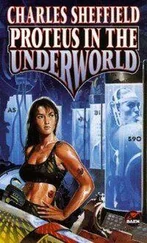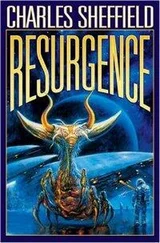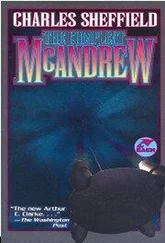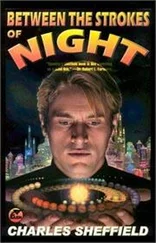At the base he halted. Darwin stood motionless. At last, the other cautiously approached. His face was a devil-mask, streaked with red ocher from mouth to ears—but the eyes were soft and dark, deep-socketed beneath the heavy brow.
Darwin held forward Pole’s fevered body. “My friend is sick,” he said. The other started back at his voice, then again came slowly closer.
“See, red-man,” said Darwin. “He burns with fever.” Again, he nodded at Pole’s silent form.
The fiend came closer yet. He looked at Pole’s face, then put a hesitant hand out to feel the forehead. He nodded, and muttered to himself. He felt for the pulse in Pole’s scrawny neck and grunted unhappily.
Darwin looked at him with an approving eye. “Aye, doctor,” he said quietly. “See the problem? If we don’t get him back home, to where I can give him medicine and venesection, he’ll be dead in a few hours. What can you do for us, red-man?”
The fiend showed no sign of understanding Darwin’s speech, but he looked at the other with soft, intelligent eyes. Darwin, no Adonis at the best of times, was something to look at. His clothes, wrinkled and smeared, hung like damp rags on his corpulent body. He had lost hat and wig in his descent into the pool, and his face was grimed and filthy from their travels through the tunnels of the mine. On his left hand, a deep cut had left streaks of dried blood along wrist and sleeve.
Darwin stood there steadily, heedless of his appearance. The fiend finally completed his inspection. He took Darwin by the arm and led him to the foot of the ledge. After slipping the rope around Jacob Pole’s body and making it fast, he called a liquid phrase to the group above. The fiends on the ledge hoisted Pole to the top and then—with considerably greater effort—did the same for Darwin. The red-smeared fiend shinned up lightly after them. The others, taking the rope with them, quietly hurried away into the dark tunnel that led from the cave.
Together, Darwin and the fiend lifted Jacob Pole and laid him gently on a heap of sheepskins and rabbit furs. The red-man then also hurried away into the darkness. For the first time, Darwin was alone and could take a good look around him on the ledge.
The area was a communal meeting-place and eating-place. Two sheep carcasses, butchered and dressed, hung from a wooden tripod near one of the fires. Pole lay on his pile of furs about ten feet from the other fire, near enough for a comforting warmth to be cast on the sick man. Darwin walked over to the large black pot that nestled in the coals there. He bent over and sniffed it. Hot water. Useful, but not the source of the tantalizing smell that had filled his nostrils. He walked to the other fire, where an identical pot had been placed. He sniffed again. His stomach rumbled sympathetically. It was mutton broth. Darwin helped himself with the clay ladle and sipped appreciatively while he completed his inspection of the ledge.
Clay pots were stacked neatly along the nearer wall. Above them a series of murals had been painted in red and yellow ocher. The figures were stylized, with little attempt at realism in the portrayal of the fiends. Darwin was intrigued to see that many of them were set in forest backgrounds, showing boars and deer mingled with the distorted human figures. The animals, unlike the humanoids, were portrayed with full realism.
The other wall also bore markings, but they were more mysterious—a complex, intertwined network of lines and curves, drawn out in yellow ocher. At the foot of that wall lay a heap of jackets and leggings, made from crudely stitched rabbit skins. Darwin’s eye would have passed by them, but he caught a faint bluish gleam from the ones farthest from the fire. He walked over to them and picked one up. It shone faintly, with the blue-green glow that they had seen moving on Cross Fell, and again near the rope bridge.
Darwin took a tuft of fur between finger and thumb, pulled it loose and slipped it into his damp coat pocket. As he did so, the red-man appeared from the tunnel, closely followed by a female fiend. She had a red-streaked face with similar markings, and was carrying a rough wooden box. Giving Darwin a wide berth, she set the box beside Jacob Pole. The red-man brought a clay pot from the heap by the wall, filled it with scalding water from the cauldron by the fire, and opened the wooden box. He seemed absorbed in his actions, completely oblivious to Darwin’s presence.
“I see,” said Darwin reflectively. “A medicine chest, no less. And what, I wonder, are the prescriptive resources available to the medical practitioner on Cross Fell?” He stooped to watch the red-man at his work.
“That one looks familiar enough. Dried bilberries—though I doubt their efficacy. And this is—what?—bog rosemary? And here is dried tormentil, and blue gentian. Sound enough.” He picked up a petal and chewed on it thoughtfully. “Aye, and flowers of violet, and dried holly leaves. You have the right ideas, red-man—I’ve used those myself in emergency. But what the devil are these others?” He sniffed at the dried leaves. “This could be bog asphodel, and I think these may be tansy and spleenwort. But this?” He shook his head. “A fungus, surely—but surely not fly agaric!”
While he mused, the fiend was equally absorbed. He selected pinches of various dried materials from the chest and dropped them into the scalding water in the clay pot. He muttered quietly to himself as he did so, a soft stream of liquid syllables.
At last he seemed satisfied. Darwin leaned over and sniffed the infusion. He shook his head again.
“It worries me. I doubt that this is any better than prancing around Jacob to ward off evil spirits. But my judgment is worthless with those drugs. Do your best, red-man.”
The other looked up at Darwin, peering from under his heavy brows. He smiled, and closed the box. The female fiend picked up the clay pot, while the red-man went to Jacob Pole and lifted him gently to a sitting position. Darwin came forward to help. Between them, they managed to get most of the hot liquid down Pole’s throat.
Darwin had thought that the female was naked except for her short skirt. At close quarters, he was intrigued to see that she also wore an elaborately carved necklace. He bent forward for a closer look at it. Then his medical interests also asserted themselves, and he ran a gentle hand along her collarbone, noting the unfamiliar curvature as it bent toward her shoulder. The woman whimpered softly and shied away from his touch.
At this, the red-man looked up from his inspection of Jacob Pole and grunted his disapproval. He gently laid Pole back on the heap of skins. Then he patted the female reassuringly on the arm, removed her necklace, and handed it to Darwin. He pointed to the red streaks on her face. She turned and went back into the tunnel, and the red-man patted his own cheek and then followed her. Darwin, mystified, was alone again with Pole. The other fiends had shown no inclination to return.
Darwin looked thoughtfully at the remains of the infusion, and listened to Pole’s deep, labored breathing. At last, he settled down on a second pile of skins, a few yards from the fire, and looked closely at the necklace he had been given. He finally put it into a pocket of his coat, and sat there, deep in speculation. One theory seemed to have been weakened by recent events.
When the red-streaked fiend returned, he had with him another female, slightly taller and heavier than the first. He grunted in greeting to Darwin and pointed to the single line of yellow ocher on her cheek. Before Darwin could rise, he had turned and slipped swiftly away again into the recesses of the dark tunnel.
The female went over to Pole, felt his brow, and tucked sheepskins around him. She listened to his breathing, then, apparently satisfied, she came and squatted down on the pile of skins, opposite Darwin. Like the other, she wore a brief skirt of sewn rabbit skins and a similar necklace, less heavy and with simpler carving. For the first time, Darwin had the chance for a leisured assessment of fiend anatomy, with adequate illumination. He leaned forward and looked at the curious variations on the familiar human theme.
Читать дальше












